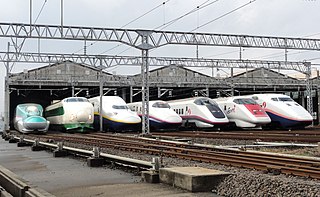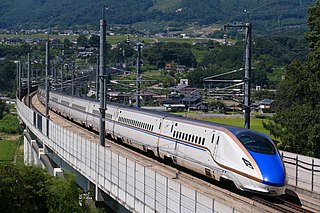
The Shinkansen, colloquially known in English as the bullet train, is a network of high-speed railway lines in Japan. Initially, it was built to connect distant Japanese regions with Tokyo, the capital, to aid economic growth and development. Beyond long-distance travel, some sections around the largest metropolitan areas are used as a commuter rail network. It is owned by the Japan Railway Construction, Transport and Technology Agency and operated by five Japan Railways Group companies.

Nozomi is the fastest train service running on the Tokaido & San'yō Shinkansen lines in Japan. The service stops at only the largest stations, and along the stretch between Shin-Ōsaka and Hakata, Nozomi services using N700 series equipment reach speeds of 300 km/h (186 mph). The trip between Tokyo and Osaka, a distance of 515 kilometres (320 mi), takes 2 hours 21 minutes on the fastest Nozomi service, with the fastest service between Tōkyō and Hakata taking 4 hours 46 minutes.

The 0 series trains were the first generation Shinkansen trainsets built to run on Japan's Tōkaidō Shinkansen high-speed line which opened in 1964. The last remaining trainsets were withdrawn in 2008.

The 100 series was a Japanese Shinkansen high-speed train type which operated between 1985 and 2012 on the Tokaido Shinkansen and Sanyo Shinkansen high-speed lines. They were introduced after the 200 series trains, but their numbering is such because in the days of Japanese National Railways (JNR), Shinkansen types running east of Tokyo were given even numbers and those west of Tokyo odd numbers, hence they were given the next odd number in line after 0, 100. The last remaining examples of the type were withdrawn from service following the last runs on 16 March 2012.

The 300 series was a Japanese high-speed Shinkansen train type, with a top operational speed of 270 km/h, which operated on the Tokaido and Sanyo Shinkansen lines in Japan between 1992 and 2012. When first introduced, they were used on the fastest Nozomi services, being capable of 270 km/h (170 mph). As more were delivered they replaced earlier units on Hikari service and allowed the thus displaced 100 series units to finally in turn displace 0 series units on almost all services.

The 400 series (400系) was a Japanese Shinkansen high-speed train type operated by East Japan Railway Company between 1992 and 2010 on Tsubasa services on Japan's first mini-shinkansen line, the Yamagata Shinkansen branch from the main Tohoku Shinkansen.

The 500 series is a Shinkansen high-speed train type operated by West Japan Railway Company (JR-West) on the San'yō Shinkansen line in Japan since 1997. They were designed to be capable of 320 km/h (198.8 mph) but operated at 300 km/h (186.4 mph), until they were finally retired from the primary Nozomi service in 2010. The trainsets were then refurbished and downgraded to the all-stations Kodama service between Shin-Ōsaka and Hakata.

The 700 series is a Japanese Shinkansen high-speed train type built between 1997 and 2006, and entering service in 1999. Originally designated as "N300" during the development phase, they formed the next generation of shinkansen vehicles jointly designed by JR Central and JR-West for use on the Tokaido Shinkansen, Hakata Minami Line and the San'yō Shinkansen. Though it has since been withdrawn from service on the Tokaido Shinkansen, it still operates on the San'yō Shinkansen and Hakata Minami Line.

The Chuo Shinkansen is a Japanese maglev line under construction between Tokyo and Nagoya, with plans for extension to Osaka. Its initial section is between Shinagawa Station in Tokyo and Nagoya Station in Nagoya, with stations in Sagamihara, Kōfu, Iida and Nakatsugawa. The line is expected to connect Tokyo and Nagoya in 40 minutes, and eventually Tokyo and Osaka in 67 minutes, running at a maximum speed of 505 km/h (314 mph). About 90% of the 286-kilometer (178 mi) line to Nagoya will be tunnels.

The Hokuriku Shinkansen (北陸新幹線) is a high-speed Shinkansen railway line jointly operated by East Japan Railway Company and West Japan Railway Company, connecting Tokyo with Kanazawa in the Hokuriku region of Japan.

The N700 series is a Japanese Shinkansen high-speed train with tilting capability developed jointly by JR Central and JR West for use on the Tokaido and San'yō Shinkansen lines since 2007, and is operated by JR Kyushu on the Kyushu Shinkansen line.

Fastech 360 is the name given to a pair of former experimental high-speed EMU trainsets developed by East Japan Railway Company to test technology for the next-generation Shinkansen rolling stock. The name is a portmanteau of Fast, Technology, and 360 km/h, the target operational speed for production trains based on the new technologies. Speeds of up to 405 km/h (250 mph) were targeted during performance testing. Results of testing using these trains was incorporated into the E5 series and E6 series trains, entering revenue service from 2011, eventually operating at 320 km/h (200 mph).

The SCMaglev and Railway Park is a railway museum owned by Central Japan Railway Company in Nagoya, Japan. The museum opened on 14 March 2011.

Class 1000 (1000形) was the classification given to the two prototype Japanese Shinkansen trains built for high-speed testing ahead of the opening of the Tōkaidō Shinkansen in 1964.

The Class 951 (951形) was an experimental Japanese Shinkansen train built to test the technology for future high-speed trains operating at speeds of up to 250 km/h (155 mph) following the opening of the Tokaido Shinkansen in 1964.

The Class 961 (961形) was a 6-car experimental Japanese Shinkansen train operated by Japanese National Railways (JNR) between 1973 and 1981.

"STAR21" was the name given to the Class 952/953 (952・953形) 9-car experimental Shinkansen train developed in 1992 by the East Japan Railway Company in Japan to test technology to be incorporated in next-generation shinkansen trains operating at speeds of 350 km/h (217 mph) or higher. The name was an acronym for "Superior Train for the Advanced Railway toward the 21st Century".

"WIN350" was the name given to the 500-900 series (500系900番代) 6-car experimental high-speed Shinkansen train developed in 1992 by the West Japan Railway Company in Japan to test technology to be incorporated in next-generation shinkansen trains expected to operate at speeds of 350 km/h (217 mph) from 1994. Initially given the designation "500X", the name "WIN350" stood for "West Japan's Innovation for operation at 350 km/h".

The N700S series is a Japanese Shinkansen high-speed train with tilting capability operated by JR Central and JR West on the Tokaido and San'yō Shinkansen lines since 2020, and JR Kyushu on the Nishi Kyushu Shinkansen line since 2022.

The E5 series and the related H5 series are Japanese Shinkansen high-speed train types built by Hitachi Rail and Kawasaki Heavy Industries.





























